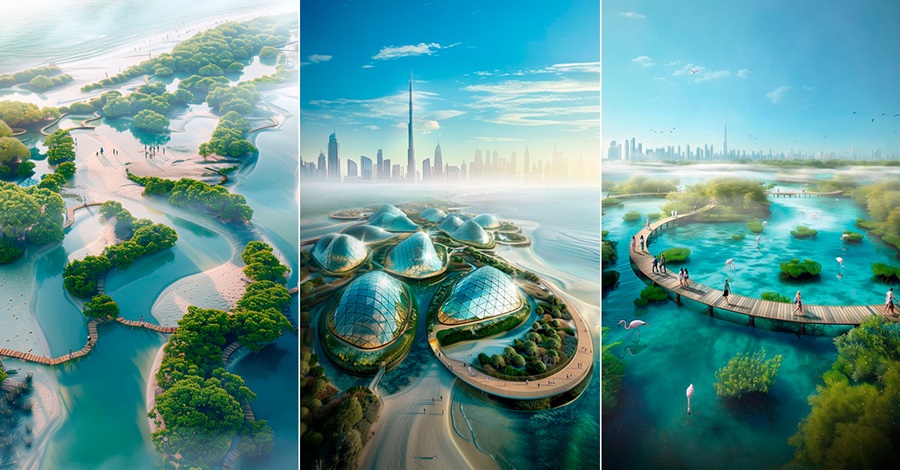Dubai revealed its plan to revitalize its coastline by planting more than 100 million mangrove trees, covering a vast stretch of 72 kilometers, aligning with the goals of the Dubai 2040 Master Plan, focusing on urban resilience, biodiversity, and sustainable planning.
The project, dubbed as the “world’s largest coastal regeneration project,” is aimed at preserving nature and urban development. The project will be led by URB, the team behind the renowned Dubai Reefs Project and The Loop.
The Dubai Mangroves project seeks to enhance urban resilience, support biodiversity, and emphasize sustainable development, in line with the environmental goals of the Dubai 2040 Master Plan.
“Dubai mangroves is a testament of how urban and environmental innovation can work in harmony as a model for cities worldwide, demonstrating the transformative power of integrating ecological preservation with urban growth,” said Baharash Bagherian, an urban planner and founder of URB.
Carbon absorption
Mangroves, renowned for their ability to absorb carbon, protect coastal regions from erosion, and nurture marine ecosystems, are central to this effort.
By absorbing around 12.3 kilograms of carbon dioxide per tree annually, the project is expected to help absorb a staggering 1.23 million tons of carbon dioxide each year. This is equivalent to eliminating the emissions of over 260,000 gasoline-powered passenger vehicles annually, showcasing the project’s profound impact on mitigating climate change.
Key Facts of Dubai Mangroves project
- Dubai Mangroves project spans 72km along Dubai’s coast.
- The project envisions the planting of more than 100 million mangrove trees.
- The entire project can sequester 1.23 million tons of CO2 annually.
- Project aims to create 10,000 eco-tourism job opportunities.
- The project is currently at the research stage with 6 pilot design studies proposed across selected zones.
- The project involves deployment of advanced technologies such as drone reforestation, satellite imagery, and artificial intelligence (AI) analytics to monitor and enhance the growth and health of mangrove forests.
- The project aims to boost ecotourism, biodiversity and resilience of Dubai.
Edutainment and conservation
In addition to ecological restoration, the project includes a range of educational and recreational amenities aimed at engaging both residents and visitors.
The Mangrove Visitor Hub, Botanical Museum, and Nature Reserve Conservation Center will serve as focal points for research, education, and advocacy, fostering environmental stewardship and awareness.
“This project is much more than coastal regeneration or resilience; it’s about setting a global standard for how cities can balance the needs of the planet with the needs of the people,” stated Baharash Bagherian, CEO of URB, emphasizing the project’s broader significance.

6 designated zones
Currently in the research phase, the project entails six pilot design studies across strategically selected zones. Designated zones include Jebel Ali Beach, Dubai Marina Beach, Jumeirah Public Beach, Umm Suqeim Beach, Mercato Beach, and Dubai Islands Beach.
These studies aim to refine mangrove restoration methodologies and explore the integration of infrastructural elements that cater to both ecological and community needs.
If realized, the project will revolutionize Dubai’s coastline, providing a wide range of amenities including parks, cycling paths, and community facilities.
Each designated zone will feature a blend of social, environmental, and leisure infrastructures, showcasing how mangrove restoration can coexist harmoniously with urban development.
Power of Mangroves
The Dubai Mangroves project seeks to harness the ecological power of mangroves by planting 100 million of these trees. Mangroves are invaluable for their ability to sequester carbon, stabilize coastlines, and support biodiversity. They serve as nurseries for marine life, enhance water quality, and act as crucial carbon sinks, aiding in the fight against climate change.
Beyond their environmental benefits, mangroves also provide socio-economic advantages by supporting fisheries, providing materials for crafts and construction, and attracting tourists. By recognizing and utilizing these benefits, the project aims to not only fortify Dubai’s coastal defenses but also contribute to global environmental efforts and set an example for sustainable development.
“Mangroves are nature’s own defense system against coastal erosion and rising sea levels, which are crucial concerns for any coastal city, including Dubai,” says Baharash Bagherian. “Currently, we’re in the research phase,” he adds. “We have identified six locations for proposed pilot studies as next stages and are focusing on the designs for those locations. We envision the project’s completion by 2040.”
With its grand vision and meticulous execution, Dubai Mangroves project heralds a new era of environmental stewardship and innovation in city development.